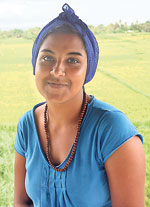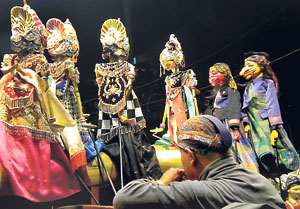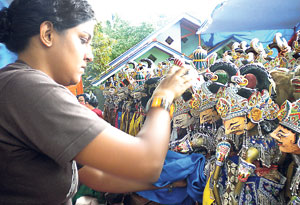I was sitting in the 'Musics of South East Asia' class taught by Gina Fatone at Bates College (ME, USA), listening to a discussion about Indonesian arts. Professor Fatone brought out an intricate three-dimensional (3D) wooden rod puppet - a main character of the epic Mahabaratha. My mind blanked for the rest of the class as I focused on the intricacy of this puppet - the minute detail on its face, the way it 'breathed' like a human and turned its head to gaze serenely at a group of awestruck students.

Sulochana Dissanayake |
Then and there I decided I wanted to see the creation of these puppets and how they 'lived' in modern times.
The Watson fellowship (granted by the T.J. Watson Foundation, USA) made it possible for me to spend six months in Indonesia, to study how ancient arts (theatre, dance and puppetry) thrive at present to tell stories that identify with local audiences. Before I left, I was told by Professor Fatone that I should study under Dalang (puppet maestro) Asep Sunandar Sunarya - nicknamed 'Superstar Dalang' due to his international fame for Wayang Golek - as that would be the best exposure to this unique form of puppetry.
Through an unexpected turn of events, I found myself sitting in his living room, with a suitcase and backpack in hand, ready to spend 2 months in his renowned artist community 'Giri Harja III' - home to one of the best Wayang Golek troupes, situated in Jelekong, Bandung (west Java). Throughout my stay, I was touched and at times overwhelmed by the generosity extended to me by Dalang Asep, his wife Ibu Nenah and their immediate family of 6 sons (ranging from age 8-23) and extended family of countless cousins. Everything I learnt regarding this art I owe to that family who treated me - a complete stranger - as one of their own.
 Giri Harja III is located at the foot of a mountain, where the majority of the mountain is occupied by fellow artists, who most often happen to be immediate or extended family of Pak Asep. At first glance it is paradise - pristine paddy fields at the foot of lush mountains, housing a village of artists, everyone dedicated to their chosen art - painting, carving, music or dalangs. But village culture combined with recent economic crisis does not always lead to a romantic picture. In previous years, it was possible for a dalang of Pak Asep's status to have 30-40 performances a month. But after the economic decline that number reduced to about 10-15 performances. Giri Harja III is located at the foot of a mountain, where the majority of the mountain is occupied by fellow artists, who most often happen to be immediate or extended family of Pak Asep. At first glance it is paradise - pristine paddy fields at the foot of lush mountains, housing a village of artists, everyone dedicated to their chosen art - painting, carving, music or dalangs. But village culture combined with recent economic crisis does not always lead to a romantic picture. In previous years, it was possible for a dalang of Pak Asep's status to have 30-40 performances a month. But after the economic decline that number reduced to about 10-15 performances.
This is still enough to make a living for a dalang - but when you consider his crew of musicians/singers and stage hands, it must feed a lot of families. In certain months of the Muslim calendar there are very few performances where the supporting artists/crew earn nothing in the absence of performances. I lived with Dalang Sunarya, yet had a good understanding of the economic difficulties faced by the artists who lived around us and frequently wondered why more of them did not actively engage in other work to supplement their main income.
Wayang Golek - 3D wooden rod puppets - are the descendants of Wayang Kulit - shadow puppets that originally came to Indonesia from India. The most popular repertoire of stories still stem from the Indian classics of Mahabarata and Ramayanaya. When I mentioned I was Sri Lankan, most Indonesians replied, 'from the country of Rawana?' Their version of the story paints Rawana as a wife thieving ogre whose greed upsets the balance between the environment and humans. It was not the most flattering character to be associated with, and I attempted to tell them that in our version Rawana genuinely loved Seetha! Either way, the philosophy of Wayang extends far beyond mere performance - it is a universe in itself. There have been volumes written on how it is a metaphor for life and cosmos by writers around the world. It takes a lifetime of close study to understand the Wayang philosophy in its entirety, so I only explored the basics and focused mostly on the performance aspect of the puppets.
 The main puppet that opens every show- 'Gunungan' (the tree of life) - maps out the various realms of life and shows the gates of heaven, giving the impression that the Dalang who sits behind it is a direct channel from God. I will not go into details of the philosophy here as I only know very little of it, having lacked the time for full comprehension. It is enough to say that it is not just a performance and is a philosophy with deep meaning connected to life. Most traditional shows are free and attract large audiences who sit around the stage - on hills, roads, on top of trees, walls or just stand - with a privileged few who clamber on to the stage to sit with the orchestra and watch the movements of the Dalang. The main puppet that opens every show- 'Gunungan' (the tree of life) - maps out the various realms of life and shows the gates of heaven, giving the impression that the Dalang who sits behind it is a direct channel from God. I will not go into details of the philosophy here as I only know very little of it, having lacked the time for full comprehension. It is enough to say that it is not just a performance and is a philosophy with deep meaning connected to life. Most traditional shows are free and attract large audiences who sit around the stage - on hills, roads, on top of trees, walls or just stand - with a privileged few who clamber on to the stage to sit with the orchestra and watch the movements of the Dalang.
The Dalang performs an impressive array of characters - easily topping 30 for a single show, with a distinct voice to match each character. I was taught that a good dalang must be an actor, director, singer, dancer, fight director, historian and a philosopher amongst many others, and be thoroughly aware of current happenings in the world. There is something for everyone in a Wayang performance - ancient philosophies for the intellectual, love for the romantics, bloody wars for the passionate, hypnotizing music for the aesthetic and physical comedy for the ones looking for pure entertainment with grotesque puppets who can vomit or whose body parts can split open/disengage from the body. Each act of the story depicts a certain stage of life and is a timeless performance that captivates the young and old alike.
A part of my study included accompanying Dalang Sunarya and co to these performances, sometimes spending several days on the road touring neighbouring cities/villages in West Java. Most full length shows last 6 hours - from 9pm till 3am, where an episode of Mahabarata or Ramayana is performed in Sudanese language, accompanied by a gamelan orchestra (with the Kendang/drum driving the music) and female singers, who intertwine songs and music with the narration. Shows are performed on personal, public or corporate invitation, for events that mark the turn of life - weddings, circumcision ceremonies, opening of a building etc - and serve a deeply religious purpose. Although the stories are Indian, they have been adapted to spread Islam in its early years, and now contain characters unique to Indonesia that is not found in the original versions.
All the musicians inject energy into the show with vocal contributions and the drums/gong heightens the punch lines of the jokes. I have yet to see a performance where the performers enjoy themselves even more than the audience! It is a regular party, and after several shows, I manage to stay awake for the entire 6 hours. They have a tradition of teasing guests by making the puppets comment on them in the midst of performance, and most often, I will know it is my time only when everyone around me points and laughs at me.
The Wayang Golek puppets themselves are works of art. The process where master carvers deftly shape blocks of light wood into expressive faces with speed is pure magic. The painting process is exquisite - I finally got the chance to see how the professionals created face details with paint brushes thinner than finely sharpened pencils, held by hands steadied by over five years of intensive training. It takes at least a decade of dedication to become the best in any area of puppet creation, and I quickly realized how little I could cover in 2 months.
My mind reeled with possibilities to adopt this ancient, dynamic art to tell Sri Lankan stories and I remembered our beloved folk tale - 'Mahadanamuththa and Golayo'. Many Sri Lankan children are raised on these stories, and I wondered how great it would be to create rod puppets for these vivid characters. I only had to mention the idea to Dalang Asep to enlist his support, where his 9th child - a talented designer named Bhatara Sena, - sketched the puppets listening to my descriptions. Within a few days, the master carver had begun carving them and I was amazed as to how quickly and easily projects can take root in this community of artists. It was my luck to be there, right in the hub of activity where the top talent resides day in and day out and all I had to do was drop the creative seed and get ready for the harvest! The set of puppets was completed to perfection, depicting a wide range of Sri Lankan characters to my delight, and their novelty (facial features, costumes etc) was appreciated even by the Indonesians!
I thank everyone who made my trip to Indonesia a possibility and will continue to be inspired by everything I experienced in this beautiful country. I wish many other Sri Lankans will have the opportunity to explore Indonesian arts and initiate sustainable cultural collaborations between our countries.
- Sulochana Dissanayake
Sulochana Dissanayake is a freelance artist based in Colombo, Sri Lanka, who spent six months in Indonesia (December 2009 - June 2010), experiencing traditional and contemporary performing arts.
She observed Teater Koma in Jakarta and Sanggar Paripurna (of Imade Sidia, Dalang and choreographer in Bona Kelod, Gianyar, Bali) in addition to studying Wayang Golek under Dalang Asep Sunandar Sunarya in Giri Harja III (Jelekong, Bandung).
At present, she is creating a Wayang Golek show in Sri Lanka in addition to writing and directing her own productions while teaching in local schools and institutions. Email: sulochana_86@hotmail.com. |


 Giri Harja III is located at the foot of a mountain, where the majority of the mountain is occupied by fellow artists, who most often happen to be immediate or extended family of Pak Asep. At first glance it is paradise - pristine paddy fields at the foot of lush mountains, housing a village of artists, everyone dedicated to their chosen art - painting, carving, music or dalangs. But village culture combined with recent economic crisis does not always lead to a romantic picture. In previous years, it was possible for a dalang of Pak Asep's status to have 30-40 performances a month. But after the economic decline that number reduced to about 10-15 performances.
Giri Harja III is located at the foot of a mountain, where the majority of the mountain is occupied by fellow artists, who most often happen to be immediate or extended family of Pak Asep. At first glance it is paradise - pristine paddy fields at the foot of lush mountains, housing a village of artists, everyone dedicated to their chosen art - painting, carving, music or dalangs. But village culture combined with recent economic crisis does not always lead to a romantic picture. In previous years, it was possible for a dalang of Pak Asep's status to have 30-40 performances a month. But after the economic decline that number reduced to about 10-15 performances. The main puppet that opens every show- 'Gunungan' (the tree of life) - maps out the various realms of life and shows the gates of heaven, giving the impression that the Dalang who sits behind it is a direct channel from God. I will not go into details of the philosophy here as I only know very little of it, having lacked the time for full comprehension. It is enough to say that it is not just a performance and is a philosophy with deep meaning connected to life. Most traditional shows are free and attract large audiences who sit around the stage - on hills, roads, on top of trees, walls or just stand - with a privileged few who clamber on to the stage to sit with the orchestra and watch the movements of the Dalang.
The main puppet that opens every show- 'Gunungan' (the tree of life) - maps out the various realms of life and shows the gates of heaven, giving the impression that the Dalang who sits behind it is a direct channel from God. I will not go into details of the philosophy here as I only know very little of it, having lacked the time for full comprehension. It is enough to say that it is not just a performance and is a philosophy with deep meaning connected to life. Most traditional shows are free and attract large audiences who sit around the stage - on hills, roads, on top of trees, walls or just stand - with a privileged few who clamber on to the stage to sit with the orchestra and watch the movements of the Dalang.